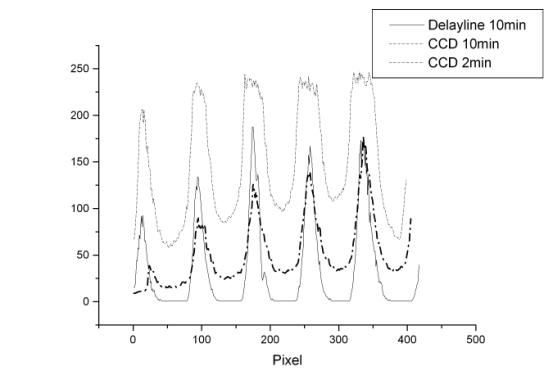|
Microchannel plates (MCP) have the potential to detect single particles with very good
position and time resolution. The simplest and commercially most used read-out method is comprising a CCD chip that records the image from a phosphor screen behind the MCP. The electron avalanche from each detected
particle is proximity-focussed onto the semi-transparent phosphor screen where
it is transformed into a localized photon shower. The image on the phosphor
screen is mapped by optics (camera, fiber taper) onto the CCD chip. The CCD
image information is read out with a certain frame rate (e.g. to a PC) so that
individual pictures or picture sequences can be stored digitally.
The time resolution of this method is defined by the frame rate and thus most
detection applications with timing demands or involving fast dynamic processes
are excluded. But even if only the imaging capability of a MCP at low frame
rates is of interest for an applications there are good reasons not
to use CCD but instead a single particle read-out method like the delay-line
technique.
Figure 1 shows the microscopic image of lithographically produced palladium strips on a
silicon layer, obtained by a PEEM (photo emission electron microscopy) that was equipped with MCP (single stage) plus phosphor screen/camera read-out
and with a MCP-delay-line detector (DLD40) as imaging device, respectively. Due
to the choice of excitation energy one should mostly observe electrons from the
palladium strips and thus obtain an image with high contrast.
|

|
Figure 1: Images of a Si/Pd sample through a PEEM
Left: with single stage MCP, phosphor screen and CCD camera
Right: with a RoentDek DLD40. The difference in contrast is obvious. Noise of
the CCD chip blurs the image. The artifacts in the right image are due to
defects in the MCP.
|
We thank the group of Prof. G. Schönhense from the division
"Surface Science, Magnetism and Electron Microscopy" of the Institut für Physik,
University Mainz for releasing these figures early.
The data have been acquired in an ongoing research project by A. Oelsner, M.
Schicketanz and Ch. Ziethen and are prepared for publication. Details of this
novel device and first results can be found soon in:
"Time-Of-Flight Photoemission Electron Microscopy - A New Way To Chemical Surface Analysis"
G. Schönhense, A. Oelsner, O. Schmidt, G. H. Fecher, V. Mergel, O. Jagutzki, H.
Schmidt-Böcking,
Surf. Sci. (in print)
"Microspectroscopy and imaging using a delayline-detector in time-of-flight photoemission microscopy"
A. Oelsner, O. Schmidt, M. Schicketanz, M.J. Klais, V. Mergel, O. Jagutzki, H.
Schmidt-Böcking, G. Schönhense, Rev. Sci. Instrum. (in print)
|
While the MCP with delay-line read-out maintains a high contrast even at long exposure
times the CCD read-out soon shows saturation and low contrast (figure 2).
|

|
| Figure 2: line scan through the Si/Pd strips. While the DLD40 maintains the right contrast even over long exposure times the CCD image suffers from noise in the "valleys" and saturates in the "peaks" at longer exposure times (y-axis is scaled to same intensities at 2 min exposure time). |
Moreover the delay-line method, as a true single-particle read-out technique, allows
determine quantitatively the intensity (the number of particles). There are no
uncertainties from an unknown efficiency of the phosphor or from losses in the
optics and in the CCD, except for the quantum efficiency of the MCP itself.
Furthermore, a single-particle read-out method will not add any extra electronic noise or blur to the image, in
fact it can eventually even discriminate some of the very low MCP-inherent dark
count noise. Thus the minimum particle flux sensitivity is just defined by the
MCP dark count rate. Even for only a few particles per second a high-contrast
image can thus be accumulated over long exposure times.
At high
rates an image contrast (ratio between brightest and darkest areas) of 10e5 and
better can be maintained for unlimited exposure times (unlimited dynamic range)
and there is no optics involved that might reduce the image quality.
Are there any disadvantages?
No.
But if a large number of particles is to be detected simultaneously or if the
particle flow exceeds 10e6/sec the delay-line method can not be applied for MCP
read-out.
back to MCP detector page
|
|

